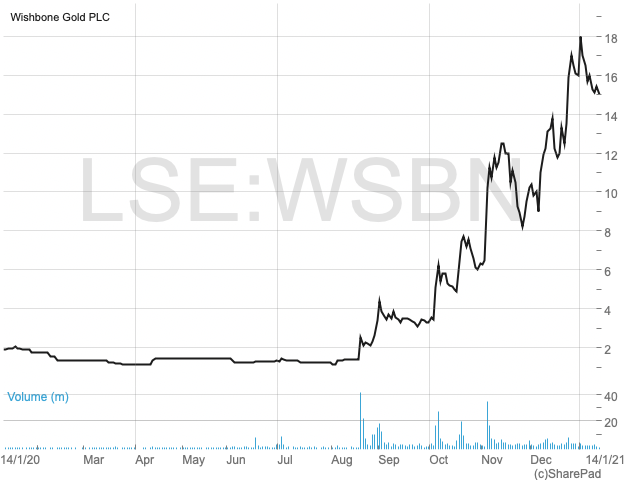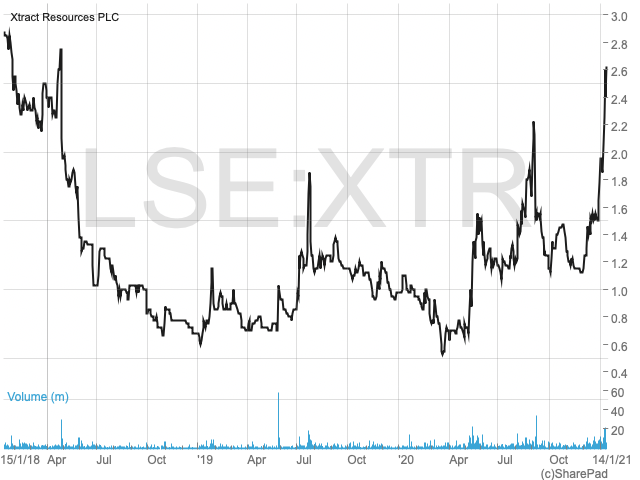John’s Mining Journal: Four rocketing mining minnows – should you follow them?

Veteran mining analyst John Cornford reviews some of the more interesting plays in the junior mining sector…
Gold’s increasingly rosy prospects started to open up exploration funding only about three years ago, allowing the likes of Greatland Gold (LON:GGP) – last year’s market darling – to at last look around for the prospects it felt would supply the commodities demand that it was certain would recover.
But at first it was a hit and miss affair. It acquired its current flagship Havieron project in Western Australia’s well-endowed Paterson region in 2016, but at that stage it didn’t seem more exciting than some of its other Australian gold, copper, and other commodities’ prospects.
It was only in 2018 when limited drilling at Havieron first returned high copper and gold grades that enabled Greatland to raise £6m in two years to continue to drill, and in 2019 to discover much more extensive mineralisation. That was sufficient to attract Australian major Newcrest (with its nearby Telfer mine running out of ore) in May 2019 to offer to carry out $65m of drilling in exchange for an eventual 75% share.

Even so, Greatland’s shares didn’t take off until eight months later in January last year, after Newcrest reported ‘further outstanding drill results showing Havieron’s true possible scale’. Before then, Greatland’s market cap had remained well below £100m.
Nine months later, after Newcrest had spent enough to earn 40%, analysts estimated that it had found the equivalent (mostly in copper) of up to 4 million gold ounces, which was confirmed in December with a JORC inferred ‘resource’ of 4.2M oz.
That means Greatland’s potential 25% share is now valued in the market at a whopping £1.3bn – twice that of Solomon Gold which has six times the resource. It means that Havieron’s stockmarket value per gold equivalent ounce is an immense 24 times that of Solgold’s world leading Alpala deposit.
There are, of course, major justifications for a large disparity, including that work to exploit Havieron will start this year – some five years ahead of Solgold’s Aplala – and that observers suggest Havieron looks like growing its resource considerably further. Mining the ore, and processing it at Newcrest’s Telfer mine will also be much cheaper.
So, obviously, market sentiment is (or maybe has been) overwhelmingly for Greatland, with practically none for Solgold. But much of that sentiment must also be down to the seemingly bright prospect over the next few years for copper at least (and maybe to a lesser extent for gold).
Even so, one wonders when Greatland’s investors might look to redeploy their profits into ‘another’ Havieron. Trading volume at the shares’ take-off under 5p in January was much higher than any since, so that many holders must have multiplied their investment by at least 5-7 times.
Maybe some have started, explaining some recently rocketing minnows. Is their performance merely some investors leaping off one, and onto another, bandwagon – or are they truly on to another Greatland? Here I’ll mention two, and another two next week.
First up is Wishbone Gold (LON:WSBN), whose value now is more than twenty times that of only five months ago when it was an unremarked AIM tiddler.
The rise followed the company’s change of direction in August when – its gold trading activities in Africa having been affected by Covid – it raised £400,000 to start exploring a long-held tenement in Queensland Australia, which had already produced relatively small amounts of gold.
But it was not until October 5th that Wishbone announced the deal which has propelled the shares a further three-fold subsequently – namely the proposed acquisition of an exploration prospect (now named ‘Red Setter’) only 17 miles from Greatland’s Havieron discovery.

Since then, Wishbone has moved quickly, and less than a month later its consultants had remodelled some available aerial survey geophysics data to identify four large magnetic targets at Red Setter ‘with a similar signature to those at Haviron’, but at considerably shallower depths.
So, who could resist taking things a lot further? Much more detailed work has just commenced in the form of a high resolution aerial magnetic survey of the whole of WSBN’s Red Setter tenements, whose results Wishbone expects by the end of the current quarter.
These will be the first to really show whether Wishbone ‘might’ have a truly exciting prospect at Red Setter, so expect the shares to remain in demand at least until they are announced. Naturally however, at the early stage at which Wishbone currently finds itself, investors will start to worry about further cash raises, or profit-taking and share pull-backs. Mostly however, they worry about their bane – the existence of the cheap warrants with which favoured clients of the brokers have usually been lured in and which they often cash for a quick profit when available. In Wishbone’s case however, the earlier ones have been converted and there are now only 10m still outstanding (at 10p) from the last placing in December, compared with a total of 150m shares now in issue.
And in addition, although it might not compensate for a disappointment at Red Setter, Wishbone and its shareholders can fall back on its Queensland prospects, where preliminary surface sampling is promising enough for Wishbone to step up its spending there.
Earlier off the blocks in June (and in the news on January 12th) was Xtract Resources (LON:XTR), which paid a mere £1.25m seven months ago to acquire the Bushranger project in another significant Australian copper-gold province, New South Wales’ Lachlan copper belt.
But, like Greatland Gold before Havieron, Xtract also had a history of sticking pins into various prospects which haven’t exactly ‘struck gold’, and its rather longer history of the same had instilled more caution into investors. But maybe their caution is abating now.

Because, whereas up to June, Xtract had concentrated on small, medium sized, and near production copper prospects in Zambia and Mozambique, its shares perked up on announcing the acquisition of the rather more prospective Bushranger.
Located in the well-endowed Lachlan Fold Belt, Bushranger’s neighbours include the world-class copper-gold mines operated by Newcrest and Hong Kong listed China Molybdenum Co (CMOC) at their Cadia-Ridgeway and North Parkes mines, together with a potentially world-class deposit at Boda discovered last year by Australia’s Alkane Resources.
Bushranger contains the Racecourse deposit which, so far, has delivered an inferred JORC resource of some 690,000 tonnes copper equivalent, with subsequent drilling showing much wider mineralisation.
As a result, after raising some £650,000 at 1.2p in September and entering into a ‘standby’ further £1m borrowing facility with Sanderson Capital (of the sort which deters some investors) Xxtract announced in early December a drilling programme to test the promising extensions to Racecourse. The first of three diamond (i.e. accurate) drill holes in a first phase, planned to go to some 800m depth, has already (Jan 12th) reached 607 metres ‘with visual copper all the way down from 110 metres’ – a highly promising early result – explaining the shares’ jump.
Drilling is to continue beyond the planned 815m depth if mineralisation continues, while the other two drills in this first phase will be followed by a second six-drill phase if results warrant it. Based on results (which will take time to be assayed and which we probably can’t expect for a few months) Xtract plans to update the resource.
Also depending on the results, Anglo-American, which first explored Racecourse six years ago but only drilled to half the depth, has a right to require 80% if further exploration delivers a deposit of more than 2 million tonnes copper equivalent, or if there is a decision to mine. In those cases, it would pay Xtract ‘fair market value’, which would obviously depend on the nature of the deposit and the economics to mine it.
And also, like Wishbone, Xtract has something to fall back on if what is spurring its shares now fails to deliver. Its copper interests in Africa comprise an alluvial gold recovery operation at Manica in Mozambique along with development of a mine, and tailings and advanced exploration operations in Zambia’s copper belt.
In partnership with a local contractor, Manica is already recovering gold and delivering revenue to Xtract, while in Zambia the Eureka project (of which Xtract has an option to acquire 50%) is finding strong copper grades. Also in Zambia, Xtract has the formerly producing Kalengwa project with tailings and potential to extend the existing pit.
For both Wishbone and Xtract it is obviously the current early stage drilling programmes in what look like highly prospective locations, with the chance they are stumbling upon some seriously large finds, that is spurring market interest. And obviously, investors are being drawn into such shares by Greatland Gold’s success, so who knows how far the momentum might take them.
I’ll be discussing two more similarly performing shares next week.
excellent article on WSBN and XTR. Just curious what your thoughts on ORCP with their very recent acquisition of very attractive gold licence?